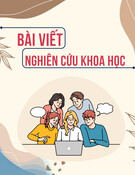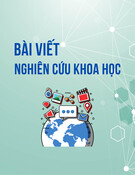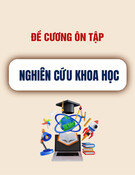
TẠP CHÍ KHOA HỌC QUẢN LÝ GIÁO DỤC SỐ 01(45), THÁNG 3 – 2025
24
TẦM QUAN TRỌNG CỦA THIẾT KẾ VÀ VẬN HÀNH CHƯƠNG TRÌNH
ĐÀO TẠO THEO HƯỚNG LIÊN NGÀNH TẠI TRƯỜNG ĐẠI HỌC:
NGHIÊN CỨU TỔNG QUAN TÀI LIỆU HỆ THỐNG
INTERDISCIPLINARY CURRICULUM IN HIGHER EDUCATION:
EXPLORING BENEFITS, CHALLENGES, AND KEY SUCCESS FACTORS
ĐOÀN THỊ MINH THOA, thoa.dtm@hcmussh.edu.vn
Vietnam National University, Ho Chi Minh City, Vietnam.
THÔNG TIN
TÓM TẮT
Ngày nhận: 08/01/2025
Ngày nhận lại: 21/01/2025
Duyệt đăng: 18/03/2025
Mã số: TCKH-S01T03-2025-B04
ISSN: 2354 - 0788
Bài báo này trình bày một tổng quan tài liệu hệ thống (Systematic
Literature Review - SLR) về tầm quan trọng của việc thiết kế và vận
hành chương trình đào tạo (CTĐT) theo hướng liên ngành tại các
trường đại học. Thông qua việc phân tích 46 nghiên cứu được công
bố trên các cơ sở dữ liệu uy tín, bài báo khám phá các lợi ích, thách
thức và các yếu tố quan trọng trong việc triển khai các chương trình
liên ngành. Kết quả SLR cho thấy rằng các CTĐT liên ngành có khả
năng thúc đẩy tư duy phản biện, năng lực giải quyết vấn đề phức tạp,
tăng cường kỹ năng hợp tác và giao tiếp, đồng thời chuẩn bị tốt hơn
cho sinh viên trong môi trường làm việc đa dạng và thay đổi nhanh
chóng. Tuy nhiên, việc triển khai các chương trình này đòi hỏi sự
phối hợp chặt chẽ giữa các khoa, sự linh hoạt trong thiết kế chương
trình, đầu tư thích đáng về nguồn lực và cam kết từ nhà trường.
Từ khóa:
Giáo dục đại học, Chương trình
đào tạo liên ngành, Thiết kế
chương trình đào tạo, Vận hành
chương trình đào tạo.
Keywords:
Curriculum Design, Higher
Education, Interdisciplinary,
Implementation.
ABSTRACT
This paper presents a systematic literature review (SLR) on the
significance of designing and implementing interdisciplinary
curricula in higher education. By analysing 46 peer-reviewed studies
published in reputable databases, this review explores the benefits,
challenges, and critical success factors associated with
interdisciplinary programs (IDPs). The SLR findings reveal that
interdisciplinary education fosters critical thinking, complex problem-
solving skills, enhanced collaboration and communication abilities,
and better prepares students for a diverse and rapidly changing
workplace. However, to implement these programs, it is necessary to
have good collaboration among departments, flexibility in curriculum
design, an adequate investment in resources, and a strong institutional
commitment.
1. Introduction
The 21st century presents global society with
significant, multifaceted challenges, including
climate change, social inequality, and rapid
technological advancement. These complex issues
require innovative, interdisciplinary solutions that
move beyond the boundary of traditional academic
fields. Consequently, the development of a
workforce proficient in interdisciplinary thinking -
integrating knowledge and methodologies from
diverse disciplines - has become increasingly
important. Traditional educational curricula, often
emphasizing a narrow disciplinary specialization,
have demonstrated limitations in adequately
preparing students to address complex,
interconnected real-world problems. Researches
have shown that interdisciplinary curricula offer
remarkable advantages, such as fostering critical
thinking, enhancing problem-solving abilities,
promoting creativity, and better preparing students
for diverse professional environments (Craig et al.,
2022; Newell, 2010). However, the design and
implementation of IDPs present considerable
challenges, including cultural differences among

ĐOÀN THỊ MINH THOA
25
academic departments, complexities in curriculum
development, and difficulties in assessing learning
outcomes (Wineburg & Grossman, 2000). Studies
on interdisciplinary curriculum design and
implementation have provided valuable insights
into their effectiveness and practical challenges
(e.g., Vink et al., 2017; Jensenius, 2012;
Manolakelli, 2022). These studies demonstrate that
interdisciplinary curricula can help learners develop
critical competencies but require meticulous
preparation and collaboration among stakeholders.
However, most of these studies are conducted in
international contexts, with limited research
focusing on interdisciplinary curriculum design and
implementation in Vietnam. This paper was
conducted in Systematic Literature Review
methodology to synthesize, evaluate, and analyze
existing research on this topic. The objective is to
clarify the significance, challenges, and success
factors associated with the implementation of
interdisciplinary curricula in higher education
institutions. This review was guided by the
following research questions:
1) What are the benefits that interdisciplinary
curricula offer to students and institutions?
2) What challenges are encountered in the design
and implementation of interdisciplinary curricula?
3) What key factors contribute to the successful
implementation of interdisciplinary curricula?
2. Research Methodology
For the systematic review, the Scopus
database owned by Elsevier in the Netherlands
was used. The selection of articles for analysis
focused on the field of education and was
conducted on December 20, 2024. Access to
the database and data extraction were
facilitated through a paid account provided by
the VNUHCM. The VOSviewer tool,
developed by Leiden University, was utilized
for data analysis and visualization (van Eck &
Waltman, 2009). A total of 1.453 journal
articles, theses, dissertations, and conference
proceedings were queried in the first search
from the databases.
Table 1. Search terms and initial limiters
Search terms
Databases
Limiters
Interdisciplinary education
Interdisciplinary curriculum
Higher education
University
Curriculum design
Program implementation
Curriculum implementation
Scopus
Scholarly articles, conference
proceedings, dissertations, and theses
(Source: Compiled by the author)
In the second step, many articles were
removed following the inclusion and
exclusion criteria (Bartholomew &
Yoshikawa, 2018). After removing duplicate
articles, the systematic review process's
initial step involved analyzing each article's
abstracts. The author conducted a review and
further excluded articles that did not meet the
inclusion criteria. Following the abstract
analysis, a final set of 46 articles was selected
for in-depth examination. Information
deemed significant, such as author names,
publication years, article titles, and the main
themes and contributions of each article, was
extracted and compiled into a matrix. This
matrix served as the foundation for the
systematic literature analysis, enabling a
comprehensive exploration of the key
findings and insights offered by the selected
articles. Table 2 demonstrates the inclusion
and exclusion criteria, Figures 1 and 2
display the screening process.
Table 2. Inclusion and exclusion criteria
Inclusion criteria
Exclusion criteria
Peer-reviewed
Full text available from the database
Published in English
Higher education
Published in other languages
Unrelated to the research topic
Not focused on undergraduate students
(Source: Compiled by the author)

TẠP CHÍ KHOA HỌC QUẢN LÝ GIÁO DỤC SỐ 01(45), THÁNG 3 – 2025
26
(Source: Compiled by the author)
Figure 1. PRISMA flow chart of article selection process
3. RESULTS AND DISCUSSION
3.1. Approaches to Interdisciplinary Curriculum
Design and their Significance
Throughout the development of education,
various approaches have been adopted in
curriculum design, ranging from discipline-
specific to multidisciplinary, interdisciplinary,
and transdisciplinary approaches (Jacobs, 1989;
Smith & Karr-Kidwell, 2000). While the
discipline-specific approach provides in-depth
knowledge and skills in a particular field, it often
neglects connections with other areas, limiting
learners' ability to view problems holistically. In
contrast, the multidisciplinary approach
combines knowledge from multiple disciplines
but maintains their relative independence,
resulting in fragmented information and limited
integration (Choi & Pak, 2006). This hinders
learners' ability to effectively apply knowledge
in real-world contexts. The interdisciplinary
approach, on the other hand, seeks to integrate
knowledge, methods, and theories from different
fields to create a new perspective where disciplines
interact and influence each other (Lattuca, 2001).
This approach enables learners to develop a
comprehensive knowledge framework, equipping
them with the flexibility and creativity needed to
address complex problems. Lastly, the
transdisciplinary approach transcends disciplinary
boundaries, addressing complicated issues through
collaboration among various stakeholders
(Nicolescu, 2002).
This approach requires learners to possess
systems thinking, teamwork, and effective
communication skills to develop practical solutions.
Among these approaches, the interdisciplinary
approach is widely endorsed by educators due to its
ability to bridge connections across disciplines, focus
on learner engagement, and encourage active
participation (Baishya, 2014). It also equips learners
with essential knowledge and skills to adapt to
societal changes. The analysis revealed numerous
benefits of interdisciplinary curricula, summarized in
Table 3 below:
Table 3. Benefits of Interdisciplinary Curriculum
Benefit
Description
Related Studies
Developing critical
thinking and solving
complex problems
Interdisciplinary curricula enable
students to approach issues from
multiple perspectives, using diverse
methodologies, fostering critical
thinking and comprehensive, creative
problem-solving skills.

ĐOÀN THỊ MINH THOA
27
Benefit
Description
Related Studies
Enhancing
collaboration and
communication
skills
Working in a multidisciplinary
environment helps students develop
teamwork and effective communication
skills, including respect for diversity
and negotiation for consensus.
Craig et al. (2022), Akhtar et al. (2024),
Zang et al. (2023), Chang et al. (2022), Su
(2024), de Reviere (2024), Liu (2021,
2021a), Zenk (2024), Chan (2021), Righi
et al. (2021), Oprisan (2022), Madden et
al. (2013), Novis-Deutsch et al. (2024),
Holley (2009), Woods (2007)
Better preparation
for the job market
IDPs equip students with diverse skills
such as adaptability, systems thinking,
and the ability to work in diverse teams,
essential for success in a rapidly
changing labor market.
Fostering creativity
and innovation
Combining knowledge and
methodologies from various fields
generates new, groundbreaking ideas,
driving innovation in science,
technology, and society.
(Source: Based on Scopus database, edited by author)
First, they allow students to approach issues
from multiple perspectives, employing diverse
methodologies, thereby cultivating critical
thinking and comprehensive, innovative
problem-solving abilities (Craig et al., 2022;
Repko, 2012). Additionally, engaging in a
multidisciplinary environment enhances
students' collaboration and communication
skills. This includes fostering teamwork,
effective communication, respect for diversity,
and negotiation skills to reach consensus (Liu,
2021; Holley, 2009).
Moreover, IDPs better prepare students for
the job market by equipping them with versatile
skills such as adaptability, systems thinking, and
the ability to work in diverse teams. These
competencies are increasingly vital for success
in a dynamic and rapidly changing labor
environment (Zang et al., 2023; Novis-Deutsch
et al., 2024). Finally, the integration of
knowledge and methodologies from various
disciplines stimulates creativity and innovation,
generating groundbreaking ideas that contribute
to advancements in science, technology, and
society (Madden et al., 2013; Su, 2024).
These benefits are particularly crucial in
addressing complex, multifaceted global challenges
such as climate change, public health, and digital
transformation. By adopting a multidimensional
and flexible approach, IDPs not only support
students in developing individual competencies but
also prepare them to become responsible global
citizens capable of contributing to sustainable
societal development.
3.2. Characteristics and Implementation of
Interdisciplinary Curricula
Interdisciplinary curricula differ significantly
from traditional discipline-specific programs
(Smith & Karr-Kidwell, 2000). These programs
intentionally integrate knowledge across subjects
to address real-world issues (Jacobs, 1989). They
emphasize relationships and connections between
disciplines, encouraging learners to explore links
across various fields. Active student participation
is another key feature, as students are motivated to
collaborate and integrate ideas from different
disciplines (Newell & Green, 1982). Additionally,
interdisciplinary curricula foster critical thinking
and problem-solving skills, enabling students to
analyze complex issues from diverse perspectives
and propose integrated solutions (Repko, 2008).
Designing an interdisciplinary curriculum
requires close collaboration among faculty
members from different fields (Wineburg &
Grossman, 2000). The process begins with
identifying learning objectives that are
interdisciplinary, specific, measurable,
achievable, relevant, and time-bound (SMART).
Following this, the selection and integration of
content should align with these objectives while
highlighting connections across disciplines.
Learning activities and teaching methods must
encourage interaction, discussion, collaboration,
and real-world application through active
teaching strategies such as Problem-Based
Learning, Project-Based Learning, and case
studies. Learning materials should also support
integration, drawing from diverse resources and
guiding students on their effective use.
3.3. Challenges and Solutions in Interdisciplinary
Curriculum Implementation
Effective implementation of interdisciplinary
curricula requires adequate preparation in terms of
infrastructure, financial resources, and personnel.
Faculty professional development is critical to
enhancing interdisciplinary teaching capabilities,
including curriculum design, teaching methods,
learning outcome assessment, and teamwork in
interdisciplinary settings (Woods, 2007; Bleakley
et al., 2011; Modo & Kinchin, 2011). Additionally,

TẠP CHÍ KHOA HỌC QUẢN LÝ GIÁO DỤC SỐ 01(45), THÁNG 3 – 2025
28
student support systems and mechanisms for
continuous program evaluation and improvement
are essential.
However, interdisciplinary curriculum
implementation faces various challenges.
Stember (1991) identified barriers stemming
from learners (disciplinary thinking, lack of
motivation, difficulty in collaboration),
instructors (lack of experience, difficulty in
teamwork), and institutions (resource
constraints, insufficient support). To overcome
these obstacles, building an active learning
community that fosters interaction, experience-
sharing, and mutual learning among learners and
educators is crucial. Providing training and
support for faculty and students is equally
important for skill enhancement. Establishing
mechanisms for evaluating and recognizing
interdisciplinary learning outcomes ensures
fairness and transparency. Furthermore, efforts
to shift disciplinary mindsets and foster
collaboration and integration across fields are
essential. The findings from the SLR highlight
the significant challenges associated with both
the design and implementation of IDPs, which
are detailed in Table 4.
Table 4. Challenges in Designing and Implementing IDPs
Challenge
Description
Related Studies
Coordination
among
departments
Developing IDPs requires close collaboration among
departments, which may face difficulties due to differences
in academic culture, objectives, processes, and evaluation
systems.
Torruellas Garcia et al.
(2022), Baishya (2014),
Ellis & Stuen (1998),
Holley (2017), Davies &
Devlin (2007), Khan et al.
(2023), Modo & Kinchin
(2011), Stember (1991),
Wineburg & Grossman
(2000), Holley (2009),
Franks et al. (2007),
Hollmén (2015), Roshania
et al. (2023).
Designing
flexible
programs
IDPs must be highly flexible to adapt to rapid changes in
knowledge and practical demands. However, integrating
content from various fields in a coherent and meaningful
way poses a challenge.
Faculty
expertise
Faculty members must possess the knowledge, skills, and
experience necessary to teach interdisciplinary courses,
including teamwork, interdisciplinary communication, and
adaptability in teaching methods.
Assessment of
outcomes
Evaluating the outcomes of IDPs is complex due to the
multidimensional and less quantifiable nature of objectives.
Effective assessment methods, incorporating both
quantitative and qualitative approaches, are essential.
(Source: Based on Scopus database, edited by author)
First and foremost, coordination among
departments and academic units is a major
obstacle. Developing such programs necessitates
close collaboration among stakeholders, yet
differences in academic cultures, goals,
workflows, and evaluation systems can result in
conflicts or a lack of consensus (Baishya, 2014;
Khan et al., 2023; Stember, 1991).
Second, program design must ensure a high
degree of flexibility to accommodate the rapidly
evolving nature of knowledge and practical
demands. However, selecting and integrating
content from diverse fields in a logical and
meaningful manner is a considerable challenge,
requiring careful deliberation on both content and
instructional methods (Khan et al., 2023;
Torruellas Garcia et al., 2022).
Faculty expertise is another critical factor in
the success of IDPs. Faculty members not only
need deep knowledge and specialized skills but
also must be proficient in teamwork,
interdisciplinary communication, and innovative
teaching methods to meet the multidimensional
requirements of these programs (Hollmén, 2015;
Wineburg & Grossman, 2000).
Finally, assessing student outcomes in IDPs
is particularly challenging due to the
multidimensional and often qualitative nature of
the objectives. Developing effective assessment
methods that combine both quantitative and
qualitative approaches is essential to accurately
reflect student achievements (Torruellas Garcia
et al., 2022; Ellis & Stuen, 1998). Addressing
these challenges requires substantial investment
in effort and resources from all stakeholders, and
strategically leveraging the key success factors
outlined in Table 5 to ensure the success and
sustainability of IDPs.









![Chính sách giáo dục và đào tạo [mới nhất]: Tổng quan và phân tích chuyên sâu](https://cdn.tailieu.vn/images/document/thumbnail/2025/20250716/truonglam.lxagvn@gmail.com/135x160/76881752736919.jpg)
















